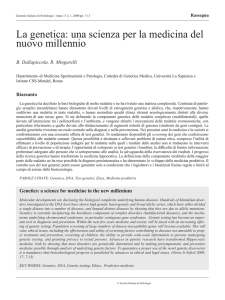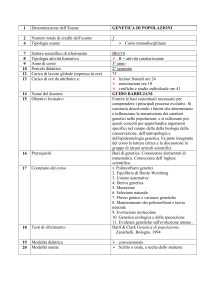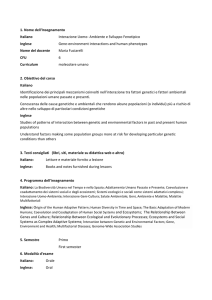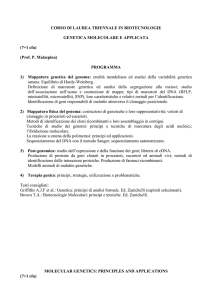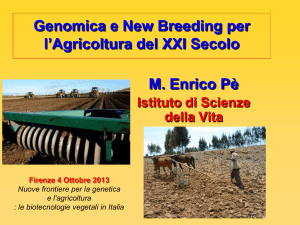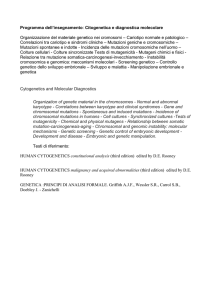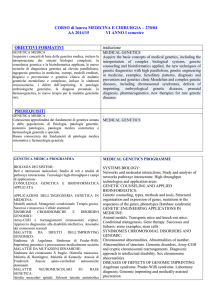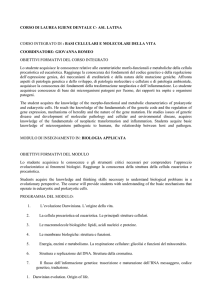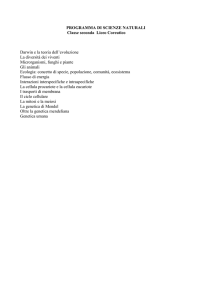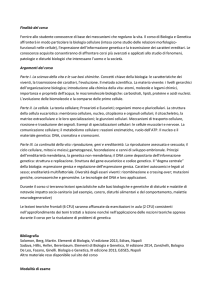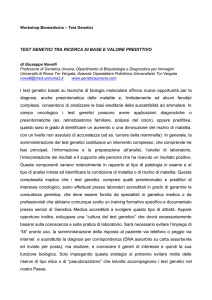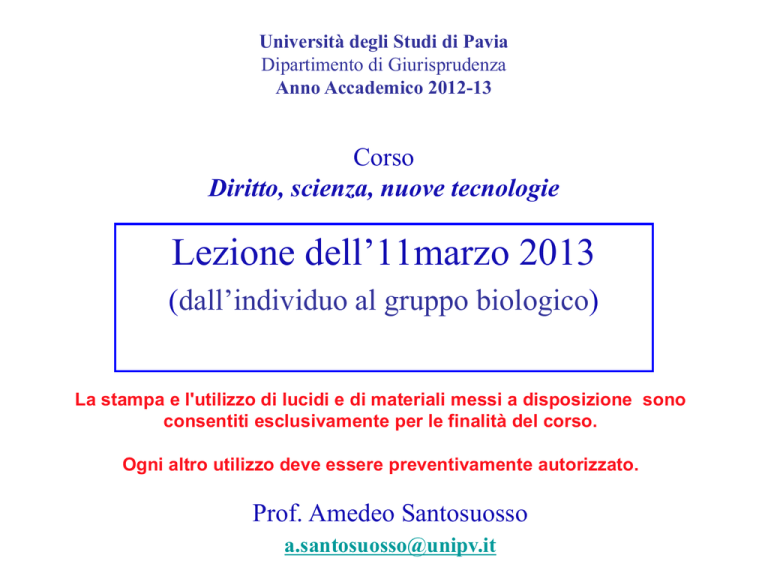
Università degli Studi di Pavia
Dipartimento di Giurisprudenza
Anno Accademico 2012-13
Corso
Diritto, scienza, nuove tecnologie
Lezione dell’11marzo 2013
(dall’individuo al gruppo biologico)
La stampa e l'utilizzo di lucidi e di materiali messi a disposizione sono
consentiti esclusivamente per le finalità del corso.
Ogni altro utilizzo deve essere preventivamente autorizzato.
Prof. Amedeo Santosuosso
[email protected]
La sovranità dell’individuo
Legami biol/genetica
•
•
•
PMA
Libertà ricerca scientifica
Brevetti biotech
•
•
•
•
Genetic (natural ?) ties
Biobanking
StemCells
Evolutionism and Law
Neuroscienze e diritto
• Penale
• Civile
• BCI
• AI
• ICT
• Robots
• AMI
Artificial (?) Connections
Quale diritto per tutto ciò?
Come cambiano i sistemi
giuridici e le fonti
2
Parte fissa
Parte variabile: ………………………
Parte fissa
Parte variabile: ………………………
Parte fissa
Parte variabile: ………………………
Parte fissa
Parte variabile: ………………………
Parte fissa
Parte variabile: ………………………
Parte fissa
Parte variabile: ………………………
La sovranità dell’individuo
The Charter of fundamental rights of the EU
…the Union “places the individual at the heart of its
activities, by establishing the citizenship of the
Union and by creating an area of freedom, security
and justice”
“Nature” from a legal point of view
4
I “Savi” di Fausto Melotti
5
6
Quando sorge questo sistema?
Quello precedente era il ……… ?
Quale è stato il fattore di cambiamento ?
…..
7
L’ordine giuridico patriarcale
8
9
10
Corte Costituzionale Sent. N.161/1985
11
What about these cases/situations ?
I decide how/when my life ends!
12
What about these cases/situations ?
Each individual is able to decide
how/when her/his own life ends!
13
What about these cases/situations ?
Each individual is able to decide
how/when her/his own life ends!
14
New Jersey
v.
Japan
15
On Liberty
by John Stuart Mill
16
On Liberty
by John Stuart Mill
“… there is a sphere of action in which society, as distinguished
from the individual, has, if any, only an indirect interest;
comprehending all that portion of a person's life and conduct
which affects only himself, or, if it also affects others, only with
their free, voluntary, and undeceived consent and participation.”
“… the appropriate region of human liberty…”
17
On Liberty
by John Stuart Mill
“It comprises, first, the inward domain of consciousness”
“Secondly, the principle requires liberty of tastes and pursuits;
of framing the plan of our life to suit our own character; of
doing as we like, subject to such consequences as may follow;
without impediment from our fellow-creatures, so long as what
we do does not harm them even though they should think our
conduct foolish, perverse, or wrong.
Thirdly, follows the liberty of combination among individuals;
freedom to unite, for any purpose not involving harm to others:
the persons combining being supposed to be of full age, and
not forced or deceived.”
18
On Liberty
by John Stuart Mill
Two basic assumptions
a) Society v. individuals
b) Individual v. each other individual
19
La prospettiva
I confini biologici dell’individuo sono frammentati a
livello individuale
Il controllo è rimesso alle libere scelte dell’individuo,
mentre la società e il diritto stabiliscono le sole regole
di compatibilità
20
21
22
A conceptual clash ?
“Nature teems with latent life, which man has
large powers of evoking under the forms and to
the extent which he desires.
We must not permit ourselves to consider each
human or other personality as something supernaturally added to the stock of nature, but rather as
a segregation of what already existed, under a
new shape, and as a regular consequence of
previous conditions.
23
A conceptual clash ?
Neither must we be misled by the word
‘individuality’, because […] our personalities are
not so independent as our self-consciousness leads
us to believe.
We may look upon each individual as something
not wholly detached from its parent source.
There is decidedly a solidarity as well as a
separateness in all human, and probably in all
lives whatsoever […]
24
A conceptual clash ?
All life is single in its essence, but various, ever
varying, and inter-active in its manifestations, and
men and all other living animals are active
workers and sharers in a vastly more extended
system of cosmic action.”
25
A conceptual clash ?
Francis Galton 1869
Hereditary Genius
eugenics
1859 John Stuart Mill
individualization
On Liberty
26
27
Sul passo di Francis Galton
• E’ un punto di vista scientifico sulla società e
sull’essere umano
• NON ha alcuna rilevanza giuridica, al momento.
• I primi riflessi giuridici sono nella legislazione eugenica, a
partire da inizio ‘900
28
29
A conceptual clash ?
The Galton’s prophecy ?
Individuo
diritti/libertà
30
The Massachusetts Institute of Technology (MIT), The third revolution: the convergence of the
life sciences, physical sciences and engineering, 4 January 2011,
http://web.mit.edu/dc/Policy/MIT%20White%20Paper%20on%20Convergence.pdf
1950
1960
1970
…….
…….
…….
…….
…….
…….
……. …….
…….
…….
…….
…….
…….
……. …….
…….
…….
…….
…….
…….
1980
1990
2000
2010
……. …….
…….
…….
…….
…….
…….
……. …….
…….
…….
…….
…….
…….
……. …….
…….
…….
…….
…….
…….
……. …….
…….
…….
…….
…….
……. 32
APPLICAZIONI DELLA GENETICA
RISVOLTI GIURIDICI
a)
b)
c)
d)
e)
f)
g)
h)
i)
j)
k)
l)
Terapie geniche
Counseling genetico, diagnosi preimpianto e diagnosi prenatale
Test genetici: predittivi e presintomatici
Dati genetici condivisi
Dati genetici e assicurazioni
Dati genetici e datori di lavoro
Studi di popolazione
Clonazione umana
Cellule staminali di origine embrionale
Biotecnologie e proprietà intellettuale
Utilizzi nel processo civile (accertamento paternità…)
Utilizzi nel processo penale (identificazione, capacità…)
33
APPLICAZIONI DELLA GENETICA
RISVOLTI GIURIDICI
a) terapie geniche
Tecnica
Obiettivo ideale: rimpiazzare un gene malato con una sua copia
sana (ricombinazione omologa), una vera sostituzione;
Modalità attuale: aggiunta del gene sano a quello malato, nella
speranza che la sua azione possa annullare l’effetto della
mutazione.
Primo esperimento al mondo 1990, Clinical Center del National Institute di
Bethesda (US) su una bambina di 4 anni affetta da deficit dell’enzima ADA
(prognosi infausta a breve)
Primo esperimento in Europa 1991, Istituto San Raffaele di Milano (I)
Tutti gli interventi sono preceduti da un parere di un comitato etico.
34
Comitato Nazionale Bioetica 15.2.91
APPLICAZIONI DELLA GENETICA
RISVOLTI GIURIDICI
a) terapie geniche
Norme
Consiglio d’Europa, Raccomandazione sull’ingegneria genetica n. 934 (1982)
1.
2.
3.
Il diritto alla vita e alla dignità dell’uomo “implicano il diritto di ereditare
caratteri genetici che non abbiano subito alcuna manipolazione”
Unico intervento che può essere giustificato sull’uomo è quello di tipo
terapeutico
Sarà opportuno tracciare le grandi linee di una regolamentazione volta a
proteggere gli individui contro le applicazioni di tali tecniche a fini non
terapeutici.
Consiglio d’Europa, Racc. n. 1046(1986) e n. 1100 (1989)
•
•
•
•
Bisogna evitare che qualcuno determini le caratteristiche genetiche di
qualcun altro, senza la sua volontà e per motivi non degni di tutela;
Non è precluso l’intervento sul patrimonio genetico sull’embrione, in
vitro o in utero, o sul feto o su già nati;
Ci deve essere una necessità terapeutica
35
Deve essere compilata una lista di patologie.
APPLICAZIONI DELLA GENETICA
RISVOLTI GIURIDICI
a) terapie geniche
Diritto ad un patrimonio genetico non manipolato?
caratteri non patologici
caratteri patologici (terapia genica somatica)
Diritto all’integrità genetica:
“diritto ad ottenere l’assistenza necessaria a raggiungere un’identità genetica liberata
dalle minorazioni che ne hanno colpito la struttura” (documento CNB del 15 febbraio
1991).
36
APPLICAZIONI DELLA GENETICA
RISVOLTI GIURIDICI
a) terapie geniche
Categorie giuridiche ed etiche di riferimento
•
Diritto alla salute (art. 32 Cost.)
•
Libertà personale (art. 13 Cost.)
•
Identità personale (art. 2 Cost.)
•
Art. 3 Carta di Nizza (integrità della persona)
•
Trattamenti sanitari sperimentali (norme di buona pratica clinica: Good Clinical
Practice; Dichiarazione di Helsinki; Convenzione di Oviedo)
•
Principio di consequenzialità (J. S. Mill): non lesione di terzi, (interventi su linea
germinale ?)
37
APPLICAZIONI DELLA GENETICA
RISVOLTI GIURIDICI
a) terapie geniche
Il caso Jesse Gelsinger
1999 (US): Jesse Gelsinger muore a 18 anni a seguito di un tentativo di terapia genica (Università
della Pennsylvania)
Malattia: una forma di grave epatopatia
Terapie disponibili: controllo con farmaci e con una dieta a basso contenuto proteico (terapia
seguita).
Parere del Comitato etico: intervento “difficile da giustificare in pazienti che sono relativamente in
salute”.
Consenso alla sperimentazione: SI, ha voluto partecipare ed era maggiorenne.
QUESITI
Può un adulto decidere di correre il rischio di morire solo per migliorare la
propria qualità della vita?
Abbiamo bisogno di categorie giuridiche eccezionali?
38
APPLICAZIONI DELLA GENETICA
RISVOLTI GIURIDICI
a) terapie geniche
Terapia genica germinale
Comporta il trasferimento delle modificazioni ai discendenti
è promettente dal punto di vista scientifico
scarse conoscenze scientifiche acquisite
Norme
contrasta con il diritto alla identità genetica: Cons. d’Europa, Raccom. 1100 (1989) ?
art. 13, Convenzione Oviedo (1997):
•
Vieta modificazioni del genoma della discendenza;
•
Giustifica gli interventi di tipo somatico solo per finalità preventive,
diagnostiche o terapeutiche;
•
Nulla dice sulla necessità che la malattia sia grave.
Rischi
Nuova definizione di normalità
Discriminazioni su base genetica: la malattia, l’inabilità e la morte prematura come
39
deviazioni dal funzionamento tipico della specie (eco dell’eugenica)
40
Test genetici
(C.N. per la Biosicurezza e le Biotecnologie)
(1998)
Si intendono le analisi a scopo clinico di DNA,
RNA, cromosomi, proteine, metaboliti o altri prodotti
genici per evidenziare genotipi, mutazioni, fenotipi o
cariotipi correlati o meno con patologie umane
ereditabili o insorte su cellule somatiche.
Rispetto ad altri esami di laboratorio i risultati
di queste analisi, oltre che diagnostici e prognostici,
possono risultare predittivi e rendere evidente una
suscettibilità e una probabilità di sviluppare una
malattia.
Coinvolgono inoltre non solo il paziente ma anche la
sua famiglia e la sua discendenza.
41
I test genetici
CLASSIFICAZIONE
• Test diagnostici
Test per la identificazione dei portatori sani
Test preclinici o presintomatici
Test predittivi o di suscettibilità
Test per lo studio della variabilità individuale
Test farmacogenetici
Test a scopo di ricerca
42
Le malattie genetiche a base ereditaria
posso essere causate da:
• mutazioni costitutive in un singolo gene (in alcuni casi può
esservi l’interazione con fattori ambientali)
ereditarietà monogenica
• mutazioni costitutive in più geni, frequentemente in
associazione con fattori ambientali
ereditarietà poligenica
• ereditarietà cromosomica/eredidarietà mitocondriale
43
APPLICAZIONI DELLA GENETICA
RISVOLTI GIURIDICI
c) test genetici predittivi e presintomatici
test presintomatici: identificano, in un soggetto non ammalato, una condizione relativa
a una malattia che inevitabilmente si svilupperà nel corso della vita (corea di
Huntington);
test predittivi: identificano un aumento o una diminuzione del rischio di contrarre in
futuro una data malattia o suscettibilità (BRCA1, BRCA2, gene APC)
Convenzione di Oviedo (1997)
I test predittivi sono consentiti “solo a fini medici o di ricerca legata alla tutela della
salute”, e con una consulenza genetica appropriata (art. 12).
QUESITO
Si può vietare a una persona di conoscere la propria condizione genetica, anche con
la consapevolezza del basso tasso di predittività che la diagnosi di una mutazione
può comportare?
44
APPLICAZIONI DELLA GENETICA
RISVOLTI GIURIDICI
c) test genetici predittivi e presintomatici
il caso Katskee (1996, US)
il caso:
•
Una giovane donna americana (Katskee) effettua un test genetico dal quale
emerge la sua predisposizione al tumore dell’ovaio;
•
Si sottopone a rimozione chirurgica profilattica di ovaie e utero;
•
La sua assicurazione nega il rimborso in quanto non riconosce la donna come
“malata”;
•
I giudici condannano la compagnia a pagare sulla base del concetto di atto
medicalmente necessario, che rientra nel contratto di assicurazione sanitaria.
QUESITI
Come si definisce la malattia?
Qual è la differenza tra sintomo e malattia?
Può dirsi malato chi ha solo il rischio di ammalarsi?
Qual è il criterio rilevante per il diritto ?
Possono i giudici interpretare in modo estensivo una clausola
contrattuale?
45
Genetic testing and the Council of Europe
•
Convention for the Protection of Human Rights and
Dignity of the Human Being with regard to the
Application of Biology and Medicine: Convention on
Human Rights and Biomedicine - ETS no. 164
(known as Oviedo Convention)
•
Additional Protocol to the Convention on Human Rights
and Biomedicine, concerning the Genetic Testing for
Health Purposes - May 7th, 2008
•
Explanatory Report to the Additional Protocol to the
Convention on Human Rights and Biomedicine,
concerning the Genetic Testing for Health Purposes
46
47
Oviedo Convention
48
The Additional Protocol on Genetic Testing at a
glance (a)
Chapter I – Object and scope
Article 1 – Object and purpose
Article 2 – Scope
Chapter II – General provisions
Article 3 – Primacy of the human being
Article 4 – Non-discrimination and non-stigmatisation
Chapter III – Genetic services
Article 5 – Quality of genetic services
Article 6 – Clinical utility
Article 7 – Individualised supervision
Chapter IV – Information, genetic counselling and consent
Article 8 – Information and genetic counselling
Article 9 – Consent
Chapter V – Persons not able to consent
Article 10 – Protection of persons not able to consent
Article 11 – Information prior to authorisation, genetic counselling and support
Article 12 – Authorisation
49
The Additional Protocol on Genetic Testing at a
glance (b)
Chapter VI – Tests for the benefit of family members
Article 13 – Tests on persons not able to consent
Article 14 – Tests on biological materials when it is not possible to contact the
person concerned
Article 15 – Tests on deceased persons
Chapter VII – Private life and right to information
Article 16 – Respect for private life and right to information
Article 17 – Biological samples
Article 18 – Information relevant to family members
Chapter VIII – Genetic screening programmes for health purposes
Article 19 – Genetic screening programmes for health purposes
Chapter IX – Public information
Article 20 – Public information
Chapter X – Relation between this Protocol and other provisions and reexamination of the Protocol
50
Is genetic testing exceptional ?
The concept of exceptional implies that existing
ethical and legal rules are not able to face the new
problems
and
we have to create new ones.
51
Is genetic testing exceptional ?
Article 5 – Quality of genetic services
[...] a genetic tests meet generally accepted criteria of
scientific validity and clinical validity;
[...] a quality assurance programme is implemented in each
laboratory è...] persons providing genetic services have
appropriate qualifications to enable them to perform their
role in accordance with professional obligations and standards.
Article 6 – Clinical utility
Clinical utility of a genetic test shall be an essential criterion
for deciding to offer this test to a person or a group of persons.
Article 8 – Information and genetic counselling
When a genetic test is envisaged, the person concerned shall be
provided with prior appropriate information in particular on the
purpose and the nature of the test, as well as the implications52of
its results.
Is genetic testing exceptional ?
Article 9 - Consent
A genetic test may only be carried out after the person
concerned has given free and informed consent to it.
Article 10 – Protection of persons not able to consent
Subject to Article 13 of this Protocol, a genetic test on a person who does not have
the capacity to consent may only be carried out for his or her direct benefit.
Chapter VI – Tests for the benefit of family members
Article 13 – Tests on persons not able to consent
[...] the law may allow a genetic test to be carried out, for the benefit of family
members, on a person who does not have the capacity to consent, if [...] the purpose
of the test is to allow the family member(s) concerned to obtain a preventive,
diagnostic or therapeutic benefit that has been independently evaluated as important
for their health, or to allow them to make an informed choice with respect to
procreation; [...] the benefit envisaged cannot be obtained without carrying out
this test;
53
Is genetic testing exceptional ?
Assumed that the Protocol is on genetic testing for health purposes:
Quale di queste regole non potrebbe essere
applicata a altri trattamenti medici?
O quale di queste regole non funzionerebbe se
applicata a altri trattamenti medici?
(HIV, tuberculosis ...)
Ma allora, perché dovremmo avere regole così
particolari per la genetica e i test genetici?
54
Genetic Exceptionalism?
• Is there any clear demarcation that separates genetic data from
other health data?
• Can physicians always differentiate genetic information from
other information in a medical record?
• Does genetic data have a more stigmatizing effect than other
personal information related to mental health, HIV, STD and
others?
55
Genetic Exceptionalism?
In other words, the need for overtaking exceptionalism seems
to reach the target in all cases
where
• the question is strictly related to medical data as individual
data
• and privacy rules can be adapted and made to work.
56
Genetic Exceptionalism?
Is the argument over exceptionalism sound in all the fields of
application of genetics?
What about
the almost unique property of genetic data:
familiarity?
57

